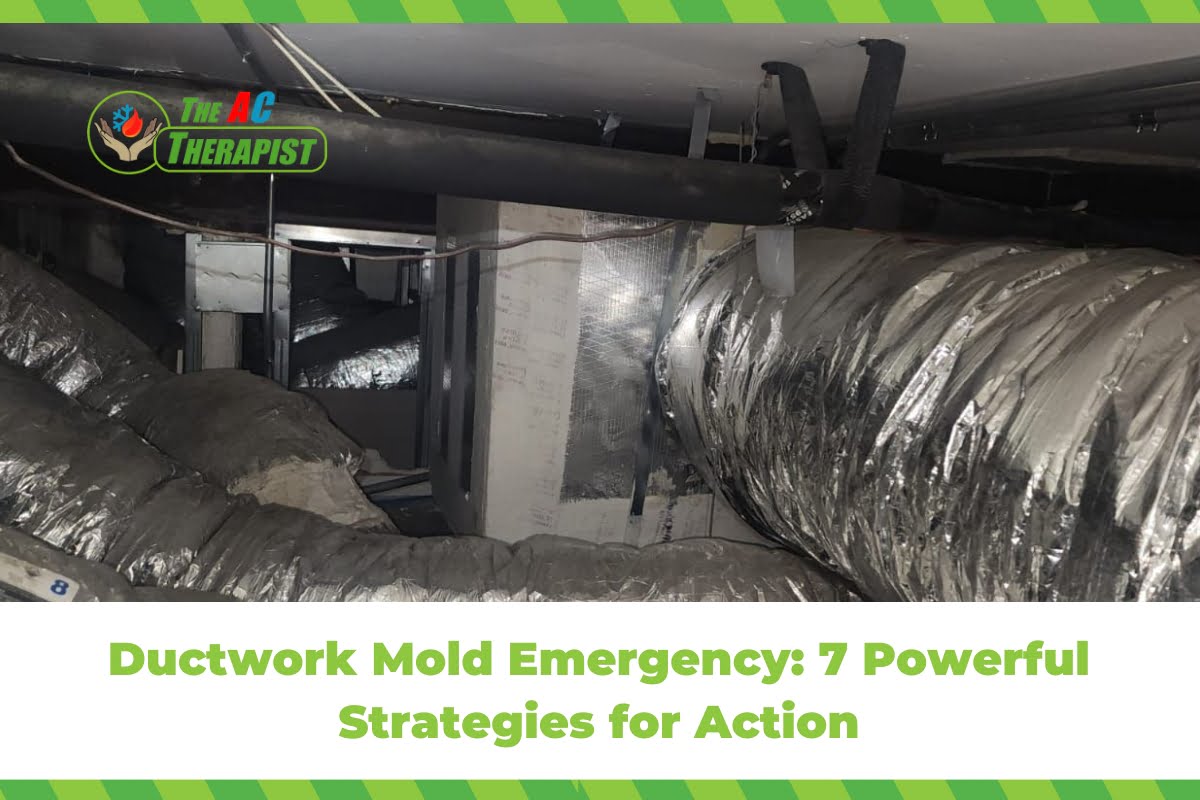Ductwork Mold Emergency: 6 Powerful Strategies for Action
Indoor air quality (IAQ) is a crucial aspect of our living and working environments. While we often focus on the visible aspects of cleanliness, there’s a hidden intruder that can silently deteriorate IAQ and pose potential health risks to mold growth in the ductwork. In this comprehensive guide, we will delve into the world of mold in ductwork, exploring its causes, effects, prevention, and the vital role HVAC contractors play in addressing this issue. As a local residential and light commercial HVAC contractor in the Tampa Bay area, we understand the significance of maintaining clean and healthy indoor air environments.
The Diverse Types of Mold
Mold is a diverse group of fungi that can vary in appearance, texture, color, and potential health effects. Here are some of the most common types of mold:
- Cladosporium: This type of mold is characterized by its dark green or black appearance. It often grows on surfaces like carpets, fabrics, and wooden materials. While it’s not typically considered highly toxic, it can cause respiratory issues and allergies in sensitive individuals.
- Penicillium: Recognizable by its bluish or greenish color, Penicillium is known for its distinctive musty odor. It can grow on various surfaces, including food, wallpaper, and HVAC systems. Certain species of Penicillium produce mycotoxins, which can affect indoor air quality and potentially cause health problems.
- Aspergillus: Commonly found both indoors and outdoors, Aspergillus comes in a variety of colors including green, yellow, and brown. Some species of Aspergillus can produce mycotoxins, which can lead to respiratory issues and allergies in susceptible individuals.
- Stachybotrys chartarum (Black Mold): This notorious mold is often referred to as “black mold” due to its dark black or greenish-black appearance. It thrives in extremely damp environments and can produce mycotoxins that have been associated with various health problems, including respiratory symptoms, headaches, and fatigue.
- Alternaria: Alternaria mold is usually green or brown with a wooly texture. It commonly grows in damp areas like showers, sinks, and around windows. Exposure to Alternaria spores can trigger allergies and exacerbate asthma symptoms.
- Fusarium: Fusarium mold can be pink, white, or reddish in color. It’s often found in water-damaged areas and can cause health issues ranging from respiratory problems to eye infections in individuals with weakened immune systems.
- Chaetomium: Chaetomium mold is recognized by its cotton-like texture and color, which can range from white to gray to brown. It’s commonly found in water-damaged buildings and may produce mycotoxins that pose health risks.
- Aureobasidium: This mold starts as pink or black and gradually turns to a darker brown color. It’s often found on wooden surfaces, painted areas, and behind wallpaper. While not considered highly toxic, it can still cause allergies and respiratory irritation.
It’s important to note that the effects of mold exposure can vary widely based on an individual’s sensitivity, the type of mold, and the extent of exposure. If you suspect mold growth in your environment, it’s recommended to consult with professionals who can identify the specific type of mold and provide appropriate remediation measures to ensure a safe and healthy indoor environment.
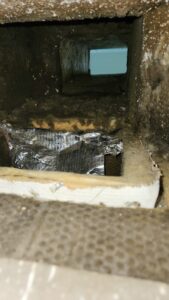
Understanding Mold Growth in Ductwork
Mold, a type of fungus, thrives in environments with moisture and organic matter. Ductwork, a network of interconnected pathways that distribute conditioned air throughout a building, can become a breeding ground for mold if conditions are met. Factors such as high humidity, leaks, inadequate insulation, and poor ventilation create the ideal environment for mold spores to settle and proliferate.
Mold growth in ductwork is a concerning issue that can have significant implications for indoor air quality and the health of occupants. Ductwork, the system of channels that distribute heated or cooled air throughout a building, can provide an ideal environment for mold to thrive if certain conditions are met. Let’s explore the causes, effects, and solutions to mold growth in ductwork.
How do I know if there is mold in my HVAC system?
Detecting mold in your HVAC system requires a combination of visual inspection, awareness of potential symptoms, and sometimes professional testing. Here are some steps to help you determine if there is mold in your HVAC system:
Visual Inspection: Start by conducting a visual inspection of the accessible parts of your HVAC system. Check the air vents, grilles, and any visible sections of your ductwork. Look for signs of mold growth, such as dark spots, discoloration, or fuzzy patches. If you notice any visible mold on these surfaces, there’s a possibility that mold is present within the system.
Musty Odor: Pay attention to the odors in your home, especially when your HVAC system is running. If you detect a persistent musty or moldy smell, it could be an indication of mold growth within the system. This smell might become more pronounced when you turn on the air conditioning or heating.
Allergic Reactions and Health Symptoms: Be mindful of any unexplained allergic reactions, respiratory issues, coughing, sneezing, or other health symptoms that occur when your HVAC system is operating. Mold spores from within the system can be circulated into your living spaces, potentially causing health problems for occupants.
Visible Mold Elsewhere: If you’ve noticed visible mold growth in other parts of your home, it’s important to consider the possibility that mold spores have been drawn into your HVAC system. Mold growth in other areas could potentially indicate a higher likelihood of mold being present within the system.
Professional Inspection and Testing: If you have suspicions but can’t confirm mold growth through visual inspection, it might be wise to consult a professional HVAC technician or an indoor air quality specialist. These experts can conduct a thorough inspection of your HVAC system, using specialized tools to assess whether mold is present. They may also perform air quality testing to detect mold spores in the air.
Air Ducts and Registers: If you’re comfortable doing so, you can remove the registers from your vents and visually inspect inside the ducts using a flashlight. Look for any signs of mold growth, unusual discoloration, or accumulations of dust and debris.
Remember that mold growth within HVAC systems is a serious concern due to the potential health risks associated with inhaling mold spores. If you suspect mold, it’s advisable to consult professionals who specialize in mold remediation or indoor air quality testing. They have the expertise and tools to accurately assess the situation, identify mold presence, and provide recommendations for proper remediation if necessary.
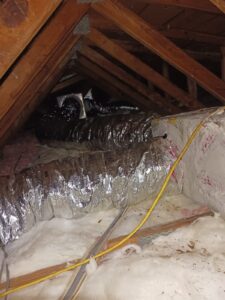
Causes of Mold Growth in Ductwork:
- Moisture Accumulation: Ductwork can accumulate moisture due to factors like condensation from temperature variations, leaks from HVAC components, or high humidity levels in the indoor environment.
- Poor Ventilation: Inadequate ventilation can lead to stagnant air and increased moisture levels within ducts, creating an environment conducive to mold growth.
- Contaminated Air: Dust, debris, and organic matter carried through the ducts can provide a food source for mold spores. When combined with moisture, this creates an ideal breeding ground.
Effects of Mold Growth in Ductwork:
- Indoor Air Quality (IAQ) Impact: Mold spores can be released into the indoor air when the HVAC system is operating, leading to compromised IAQ and potential health issues for occupants.
- Respiratory Issues: Inhaling mold spores can trigger allergic reactions, exacerbate asthma symptoms, and cause respiratory discomfort, especially in individuals with sensitivities.
- Odor and Unpleasant Environment: Mold growth often produces a musty odor that can permeate living spaces, creating an uncomfortable and unwelcoming environment.
- System Inefficiency: Mold buildup in ducts restricts airflow, forcing HVAC systems to work harder and consume more energy, resulting in reduced efficiency and increased utility bills.
Solutions and Prevention:
- Regular Maintenance: Schedule annual HVAC maintenance with a professional technician. Regular inspections and cleaning will identify potential issues before they escalate and contribute to mold growth.
- Control Humidity: Mold thrives in high humidity conditions. Use a dehumidifier to maintain humidity levels below 60%. In particularly humid areas, consider installing a whole-house dehumidification system.
- Change Filters: Regularly change HVAC filters according to the manufacturer’s recommendations. Dirty filters restrict airflow and create conditions conducive to mold growth.
- Clean Ducts and Vents: Professional duct cleaning removes accumulated dust, debris, and potential mold spores from your system. This prevents the spread of contaminants throughout your home.
- Seal and Insulate: Ensure your home’s insulation is intact and there are no leaks in your ductwork. Proper insulation prevents condensation, reducing the chances of mold growth.
- Consider UV Lights: Ultraviolet (UV) lights can be installed in your HVAC system to neutralize mold spores and inhibit their growth. UV lights are particularly effective in damp environments.
- Promote Airflow: Keep vents and registers unblocked to ensure proper airflow. Restricted airflow can lead to moisture buildup and mold growth.
- Maintain Drainage: If your HVAC system has a condensate drain line, ensure it’s clear and functioning properly. Clogged drain lines can cause water to accumulate, creating a breeding ground for mold.
Mold growth in ductwork is a serious concern that requires proactive measures to address. As a homeowner or building manager, regular maintenance, prompt repair of leaks, and proper insulation can significantly reduce the risk of mold infestations in your ducts. If mold growth is suspected or detected, seeking professional assistance for remediation is crucial to ensure a safe and healthy indoor environment for everyone.
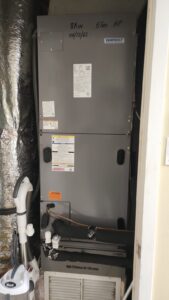
6 Powerful Strategies for Action
Strategy 1: Identify the Signs
The first step in any emergency response is to recognize the signs of ductwork mold. These may include musty odors, visible mold growth near vents, allergic reactions among occupants, and increased respiratory issues.
Strategy 2: Act Quickly
Time is of the essence in a mold emergency. The longer mold is allowed to grow and spread, the greater the health risks become. As soon as you suspect ductwork mold, initiate action promptly.
Strategy 3: Consult Professional Help
Enlist the expertise of HVAC professionals experienced in mold remediation. They possess the knowledge, tools, and protective gear required to handle mold safely and effectively.
Strategy 4: Isolate the Affected Area
To prevent mold spores from spreading to other parts of your home, close off the affected vents and seal any visible gaps or leaks in the ductwork.
Strategy 5: Improve Ventilation and Reduce Humidity
Enhance ventilation in your living space and address humidity issues to create an environment less conducive to mold growth. Using dehumidifiers and improving overall airflow can make a significant difference.
Strategy 6: Remediation and Cleaning
Professionals will employ specialized equipment to clean and remove mold from your ducts. This process may involve high-powered vacuums, agitation devices, and environmentally friendly cleaning agents.
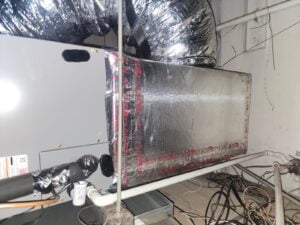
The Impact on Health and Indoor Air Quality
Mold growth indoors can have far-reaching consequences on both health and the quality of indoor air:
- Respiratory Issues: Mold spores, mycotoxins, and other byproducts can trigger allergic reactions, asthma symptoms, and respiratory problems.
- Allergies: Individuals with mold allergies may experience sneezing, runny nose, skin rashes, and itchy eyes.
- Mycotoxicosis: Prolonged exposure to certain molds and their mycotoxins can lead to mycotoxicosis, characterized by various symptoms depending on the type of mold and individual sensitivity.
- Immunocompromised Individuals: Those with weakened immune systems, such as the elderly or individuals with chronic illnesses, are particularly vulnerable to mold-related health issues.
- Structural Damage: Mold growth on surfaces can gradually degrade structures, leading to material deterioration and potential structural compromise.
Effective Mold Remediation Strategies
When mold growth becomes evident, effective remediation is essential to restore indoor air quality and prevent further damage:
- Assessment: Identify the extent of the mold infestation through a thorough inspection, often involving visual examination and possibly mold testing.
- Containment: Isolate the affected area to prevent the spread of mold spores during the remediation process.
- Removal: Physically remove mold-infested materials and clean surfaces using appropriate techniques and mold-specific cleaning agents.
- Drying: Eliminate moisture sources to ensure that the mold does not return after remediation.
- Preventive Measures: Address the root cause of moisture, improve ventilation, and take preventive actions to avoid future mold growth.
The Silent Threat to IAQ
Mold growth in ductwork poses a series of threats to indoor air quality:
- Air Contamination: As conditioned air passes through mold-infested ducts, mold spores, and particles are released into the indoor air, leading to compromised air quality.
- Respiratory Health Concerns: Inhalation of mold spores can trigger allergic reactions, and respiratory issues, and exacerbate conditions like asthma. Individuals with compromised immune systems are particularly vulnerable.
- Unpleasant Odors: Mold emits a distinctive musty odor that can permeate living spaces, creating an uncomfortable environment for occupants.
- Reduced HVAC Efficiency: Mold buildup on duct surfaces restricts airflow, forcing HVAC systems to work harder and consume more energy. This inefficiency can lead to higher utility bills.
- Spread of Contamination: Mold can easily spread to other parts of the building through the HVAC system, amplifying the problem.
The Therapy Maintenance Plans: A Holistic Solution
Introducing the Therapy Maintenance Plans: a comprehensive approach to mold prevention and HVAC system maintenance. With options like Value, Premium, and Elite plans, clients gain access to regular maintenance visits, duct sanitation, UV light installation, and more. These plans not only enhance IAQ but also extend the lifespan of HVAC systems and improve energy efficiency.
The AC Therapist’s Solution for Mold-Free Ductwork
In conclusion, the presence of mold in ductwork is a pressing concern that demands immediate attention and expert intervention. Mold growth within ducts not only compromises indoor air quality but also poses potential health risks to occupants. As discussed, mold spores can be distributed throughout living spaces, leading to respiratory issues and allergies.
By addressing mold in ductwork promptly and effectively, you can safeguard your family’s health and the efficiency of your HVAC system. The AC Therapist’s commitment to excellence and their Therapy Maintenance Plans ensure that your ductwork remains free from mold contamination and that your indoor air quality remains pristine.
In the battle against mold in the ductwork, The AC Therapist’s knowledge, experience, and tailored solutions make them a reliable ally. With their assistance, you can breathe easily, knowing that your ductwork is in capable hands. Remember, when it comes to mold in the ductwork, proactive measures taken with the support of professionals like The AC Therapist can make all the difference. Learn more about AC ductwork: https://www.youtube.com/shorts/ZQtTKR4ymR8

